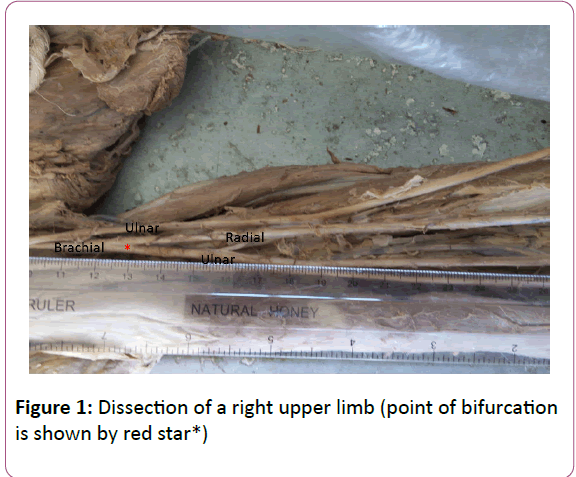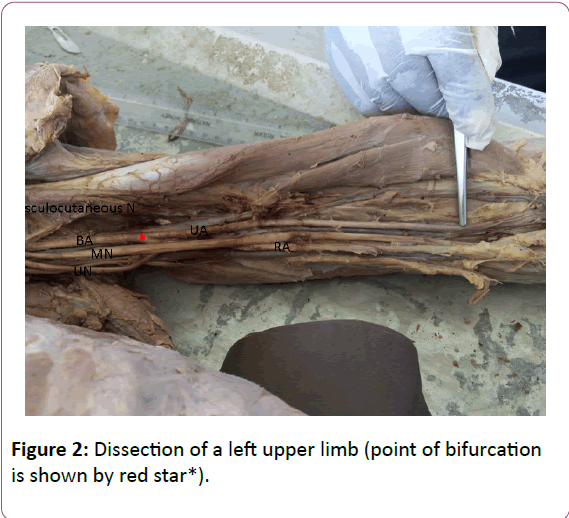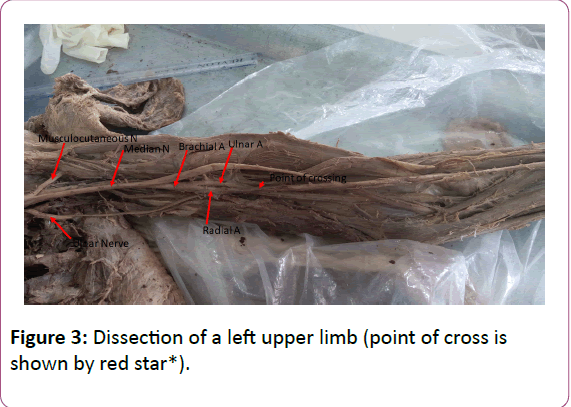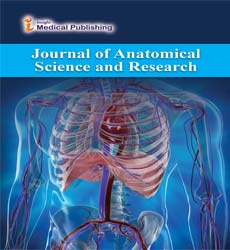High Bifurcation of Brachial Artery and its Clinical Significance
George Joseph Lufukuja*
Department of Anatomy and Histology, Hubert Kairuki Memorial University, Dar es Salaam, Tanzania (East Africa)
- *Corresponding Author:
- George Joseph Lufukuja
Department of Anatomy and Histology
Hubert Kairuki Memorial University, Dar es Salaam
Tanzania
Tel: 255717090572
E-mail: lufukuja70@yahoo.co.uk
Received date: February 08, 2018; Accepted date: February 16, 2018; Published date: February 23, 2018
Citation: Lufukuja GJ (2018) High Bifurcation of Brachial Artery and its Clinical Significance. J Anat Sci Res. Vol.1 No.1:2
Copyright: © 2018 Lufukuja GJ. This is an open-access article distributed under the terms of the Creative Commons Attribution License, which permits unrestricted use, distribution, and reproduction in any medium, provided the original author and source are credited.
Abstract
The brachial artery is the direct continuation of the third part axillary artery at the lower border of teres major muscle and normally it terminates about a centimeter distal to elbow joint (at the level of neck of the radius) by dividing into radial and ulnar arteries. This study was done on 18 cadavers which were available in the department of anatomy and the aim was to determine and find out the variations in division pattern of the main artery of the arm; brachial artery.
All the cadavers were dissected, and we found that two out of eighteen cadavers have the variation. In the first cadaver a bilateral short segment (approximately 1 cm from its origin) of the brachial artery which divide into radial and ulnar arteries at the level of the upper third of the arm. In the second cadaver, a unilateral high bifurcation of brachial artery was found in left upper limb and this was at a level nearly middle third of the arm. The general physicians, surgeons, and radiologists must be mindful to these possible anatomical variations of the brachial artery, in their daily medical diagnostic and therapeutic procedures.
Keywords
Anatomical variations; Bifurcation; Brachial artery; Radial artery; Ulnar artery
Background
The brachial artery provides the main arterial supply to the arm and is the continuation of the axillary artery. It begins at the inferior (distal) border of the teres major and ends in the cubital fossa opposite the neck of the radius under cover of the bicipital aponeurosis, where it divides into the radial and ulnar arteries [1]. At first the brachial artery is medial to the humerus, but gradually spirals anterior to it until it lies midway between the humeral epicondyles. The brachial artery is wholly superficial, covered anteriorly only by skin and superficial and deep fasciae. Its pulsation can be felt throughout [2].
As it passes inferolaterally, the brachial artery accompanies the median nerve, which crosses anterior to the artery. During its course through the arm, the brachial artery gives rise to unnamed muscular branches and the humeral nutrient artery, which arise from its lateral aspect. The main named branches of the brachial artery that arise from its medial aspect are the profunda brachii artery, superior ulna collateral artery, inferiorulnar collateral artery and the two terminal branches [1,2].
Although collateral pathways confer some protection against gradual temporary and partial occlusion, sudden complete occlusion or laceration of the brachial artery creates a surgical emergency because paralysis of muscles results from ischemia within a few hours [1]. The knowledge of arterial anatomy of the upper limbs and its common variations is very essential to all medical practitioners. It has been pointed that an appreciation of variations in the upper extremity vasculature is very essential to prevent injury, thrombosis, gangrene and even amputation of limbs, particularly in patients requiring dialysis or undergoing arteriography [3].
Anatomical variations of the arterial system of the upper extremities are quite not uncommon; however, brachial artery and its terminal branches variations are less common [4]. In a study, where 51 cadavers were studied, only one specimen (2%) of the specimens found to have bilateral higher division of brachial artery [5]. A unilateral high division of brachial artery has also been reported as a rare case [6,7].
Materials, Methods and Results
In the present study, 18 cadavers (36 upper limbs) were dissected. The brachial artery was carefully traced for its origin, course, and termination. The findings were as follows: One cadaver had a bilateral very short segment (approximately 1 cm from its origin) of the brachial artery which immediately divided into radial and ulnar arteries at the level of the upper third of the arm. In the middle of the arm, the radial artery was crossed by median nerve from medial to lateral side (Figures 1 and 2). The radial artery entered into the cubital fossa by crossing the tendon of biceps brachii superficially. In the second cadaver, we observed a unilateral high bifurcation of brachial artery was found in left upper limb and this was at a level nearly middle third of the arm. The radial artery originated medial to the ulnar artery, coursed distally for 1 or 2 cm then crossed above the ulnar artery to the lateral side (Figure 3). Though many articles reported variations in the division of brachial artery at various levels, the middle third of the arm variations are relatively of rare occurrence [7].
Discussion
A detail description of upper limb vascular variability has been described, estimated to be between 9% and 18.5% [8]. However, high origin of radial artery occurrence is said to be between 3 to 15%, also described a case of early division of brachial artery in middle of the right arm [9-11]. High division of brachial artery in the proximal third has also been reported by [12-14]. In our study early bifurcation of brachial artery was found 2 cadavers i.e. 2 left and 1 right upper limb, which is equivalent to 8.3%, out of 36 dissected upper limbs.
The anomalous blood vessels are influenced greatly by local hemodynamic factors during embryological development of the vessels. Altered hemodynamic environment may give rise to variant patterning of blood vessels [15,16].
Conclusion
The vessels of the upper limb have much more importance in different kinds of diagnostic, analytical and therapeutic studies. Consequently, it is quite significant not only for the clinicians in day to day practice but more important for vascular and plastic surgeons and radiologists to recognize variations in the number and path of the upper limb arteries.
References
- Keith LM, Anne MR (2007) Essential clinical anatomy (3rd Edn) Lippincott Williams & Wilkins pp: 439-440.
- Standring S. Gray S (2008) Anatomy (40th Edn) Spain, Churchill Livingstone, Elsevier pp: 830-835.
- Gujar SM, Oza SG, Shekhawat JP, Vikani SK, Prajapati SB (2014) A study on division of brachial artery and its clinical correlations. Int J Anat Res 2: 208-212.
- Cherukupuli C, Dwivedi A, Dayal R (2008) High bifurcation of brachial artery with acute arterial insufficiency: A case report. Vascular Endovas Surg 41: 572-574.
- Deepa TK, John M. K (2016) An anatomical study of variations in termination of brachial artery, with its embryological basis and clinical significance. Int J Med Res Health Sci 5: 85-89.
- Kumar V, Rathnakar P (2014) Unilateral high division of brachial artery: A case report and literature review.
- Rohilla A, Parmar P, Singh K, Rohilla J (2016) Unilateral high division of brachial artery and its clinical significance. Int J Res Med Sci 4: 5513-5515.
- Ciervo A, Kahn M, Pangilian AJ, Dardik H (2001) Absence of the brachial artery: Report of a rare human variation and review of upper extremity arterial anomalies. J Vasc Surg 33: 191-194.
- Anson, Morris BJ (1966) Human anatomy in the cardiovascular system-Arteries and veins. Thoms, M.Edr. Mc Grow Hill Book c. New York pp: 708-724.
- Kaur A, Sharma A, Sharma M (2017) Variation in branching pattern of brachial artery. Int J Sci Stud 5: 213-217.
- Satyanarayana N, Sunitha P, Shaik MM, Devi PS (2010) Brachial artery with high up division with its embryological basis and clinical significance. Int J Anat Var 3: 58.
- Vandana R (2012) Variation in course and branching pattern of brachial artery. Anatomica Karnataka 6: 42-48.
- Gupta J (2012) A study of brachial artery with high up division and its clinical significance. Int J Bioassays 11: 116-118.
- Rossi J, Esteves A, Simoes JS, Fernandes GJM (2011) Bilateral high division of the brachial artery in one human male cadaver: A case report. J Morphol Sci 28: 204-207.
- Arey LB (1957) Developmental anatomy in: Development of the arteries (6th Edn) Philadelphia: W.B. Saunders’ Co pp: 375-377.
- Williams PL, Bannister LH, Berry MM, Collins P, Dyson M, et al. (1999) Gray’s anatomy (38th Edn) London, Churchill Livingstone pp: 1539.
Open Access Journals
- Aquaculture & Veterinary Science
- Chemistry & Chemical Sciences
- Clinical Sciences
- Engineering
- General Science
- Genetics & Molecular Biology
- Health Care & Nursing
- Immunology & Microbiology
- Materials Science
- Mathematics & Physics
- Medical Sciences
- Neurology & Psychiatry
- Oncology & Cancer Science
- Pharmaceutical Sciences



